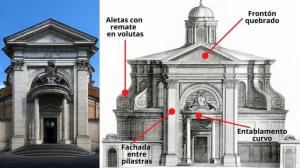Bernini's Apollo and Daphne: characteristics, analysis and meaning
Apollo and Daphne It is a marble sculpture by the Italian artist Gian Lorenzo Bernini (Naples, 1598 - Rome, 1680), made between 1622 and 1625 commissioned by Cardinal Scipione Borghese.
Inspired by mythical literature, the work stands out for its theatricality and dynamism, characteristics of a period in shock such as the Baroque period, which has left behind the classical and balanced look of the Renaissance.
Analysis of Apollo and Daphne
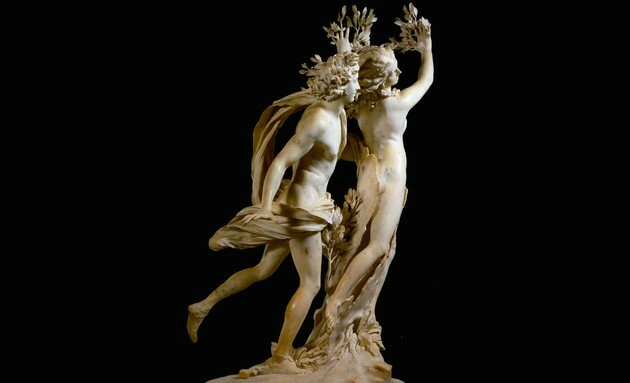
Baroque art in the West expressed a new sensibility. The rationalism, order and sobriety of the Renaissance had exhausted his discourse, and the expression of the emotions, chaos and exuberance, since the Baroque was, without a doubt, a period of dramatic historical changes and cultural
Still, the baroque does not leave behind the literary sources of the past. What he will do is look at them with new eyes, eyes with more questions than answers, that wonder about the ultimate background of those stories and the ways of representing them, on the feelings that could have animated those portrayed characters, in short, on the quality of existence human. With these eyes, Bernini contemplates the myth of Apollo and Daphne, described in
Metamorphosis of Ovid.The myth of Apollo and Daphne
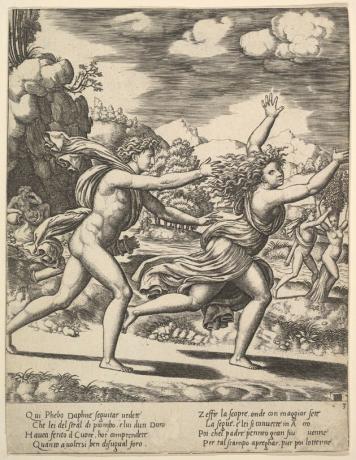
They say that Cupid and Apollo competed to show which of the two handled the bow and arrow better. Apollo, judging himself a great hunter, mocked little Cupid. Angry, Cupid decided to strike Apollo with a golden arrow that had the power to awaken love. To complete his revenge, he also struck the nymph Daphne with a blunt arrow of lead, the power of which aroused hatred.
Upon meeting Daphne, Apollo falls passionately in love with her, while the nymph runs away from him and seeks the help of her father, the Peneo River, begging him to transform her figure to evade Apollo. When finally Apollo takes her in her arms, Daphne's body is irretrievably transformed into a laurel.
Devastated and embraced by the tree, Apollo swears eternal devotion to him and promises to wear a laurel wreath on his head forever so as not to depart from him. He also promises that he will crown the heads of heroes with his blades, so that, like him, they will remember that victory is fleeting, elusive and unattainable like Daphne.
The sculptural treatment
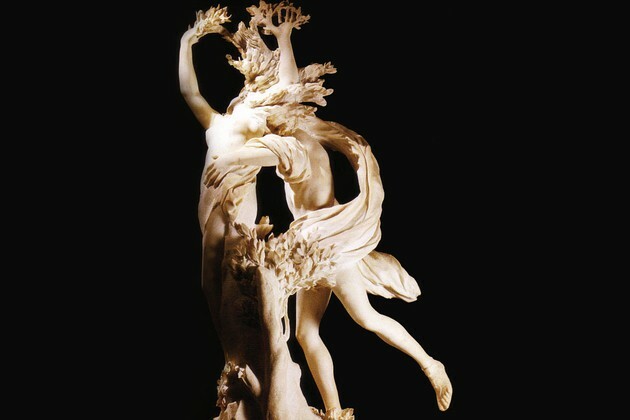
Until then, the passage of Apollo and Daphne had been frequently represented in painting, and hardly ever in sculpture due to the physical difficulties it entailed.
Bernini will therefore have some problems to think about to resolve the scene: how would Dafne feel when she was taken against her will? What anguish, what pain those of the nymph? How would Apollo's passion be transformed? How to register those emotions? How to represent the dynamic force of a process of vegetal and emotional transformation in the hard and cold stone?
Bernini does not shy away from the challenge before him. He promises to represent the exact moment in which the transformation of Daphne into the arms of Apollo begins. Thus, Bernini sculpts what will be a sculptural group of two figures, Apollo and Daphne, in Carrara marble.
To load the scene with dynamism and tension, Bernini works according to a diagonal line. On this imaginary diagonal, Bernini builds the illusion of movement.
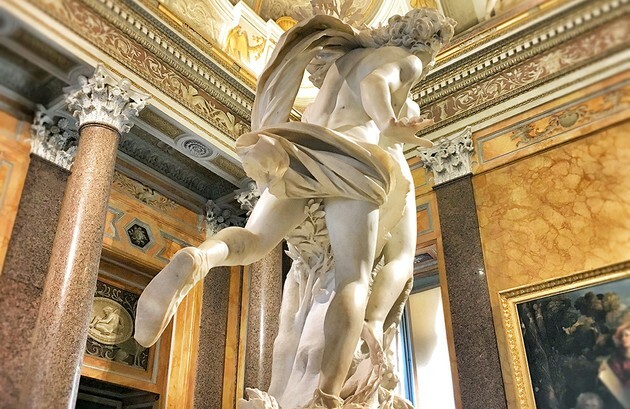
Both characters are running, one as she chases, the other as she runs away. Apollo has barely one foot on the ground. Apollo's robes emphasize movement and dynamism. These fly through the air, as do the loops of his hair and the nymph's mane.
Daphne seems to get up instantly, like someone who would have jumped. Her hands raised to the heavens, part supplication, part impulse, begin to literally branch out. At the same time, the land mass rises under his feet seeking the roots that will bind the nymph to the ground.
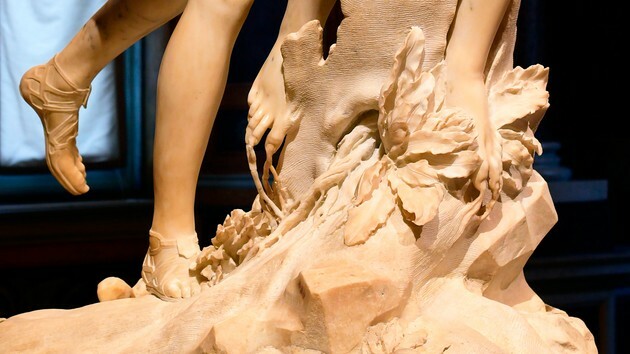
With his left hand, Apollo holds Daphne by her belly, but her skin has already begun to transform into bark. Bernini seems to suggest that Apollo is governed by both fleeting triumph and astonishment at the event. Her face contemplates, stunned, the inevitable metamorphosis of Daphne in her arms.
Meanwhile, Dafne contemplates the scene turning her head on her shoulder, expressing anguish on her tired face, her mouth resolutely open.

As a whole, the piece looks like a plastic mass that twists like a whirlwind from the ground, seeking to rise to the sky. It is Daphne's leap crying out for freedom. The diagonal line is broken and unbalanced with the introduction of sharp curves.
In the previous image, Daphne looks like a bow and Apollo the archer who stretches it, holding him by his left hand. But this hostile bow has not yielded to the arts of the divine archer. Has not Apollo seen that Daphne is not the tool of his desire? Her prey has escaped like water through her fingers.
A fundamental element will be the treatment of the various textures: the silkiness of the young skin of the characters, the chaos and dynamism of the hair strands, the roughness of the bark and roots, the irregularity of the laurel... everything is combined in search of greater verisimilitude and expressiveness.
Beyond classicism
This work by Bernini corresponds to an early period. For this reason, the sculptor still favors the classical canon of the seven and a half heads and the idealization of the bodies. In addition, in Apollo, Bernini attends to the physical features of the face of the Apollo of Belvedere, a piece from Classical Antiquity and a date in debate.
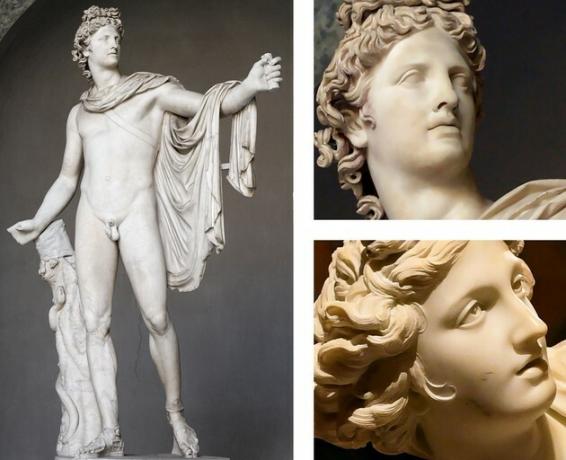
Top right: detail of Apollo Belvedere. Bottom right: Detail of Apollo and Daphne by Bernini.
However, Bernini has broken with the classicist trend by incorporating dynamism and tension, as well as the expression on the faces of the characters. We see the work loaded with a powerful pathos, that is, the expression of the moral, physical and psychological suffering of the characters, which gives the scene a dramatic sense, an aspect closer to Hellenism of antiquity than to classicism properly.
In this way, Bernini moves away from the classicist tendency of his Renaissance predecessors, and embarks towards a restless and unstable ocean: the baroque.
You may also like: Baroque: characteristics, representatives and works.
Final thoughts
Hand in hand with myth, Bernini seems to eternalize the conscience about the inevitable changes of the passions human beings, the fleetingness of triumph and pleasures, and the tension of life that is built in the struggle between opposites.
Sandra Accatino, in an article titled The Art of Looking Bernini. Daphne and Apollo, relates that at the base of the piece Bernini wrote the following words, written by Maffeo Barberini, future Pope Urban VIII:
Whoever pursues pleasure in a fleeting way, is left with a handful of leaves in hand or at most picks bitter berries.
Bernini's Apollo and Daphne video
In the following video you will be able to appreciate this magnificent work of Bernini from all possible angles.


